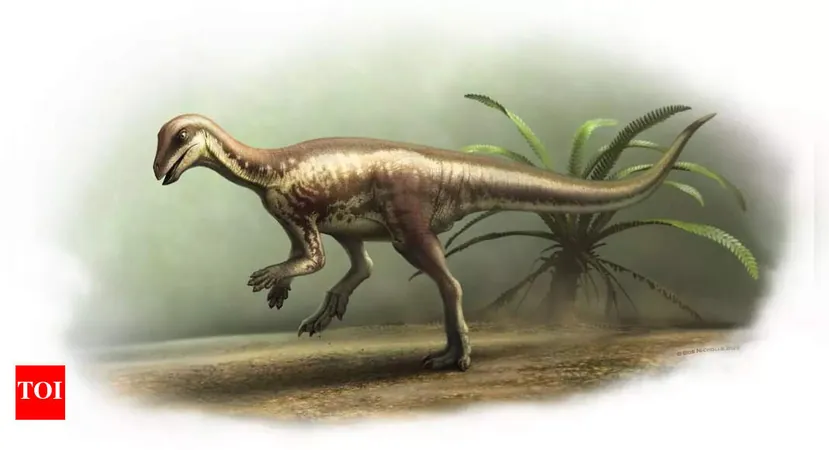
Unlocking the Secrets of Hawaiian Volcanoes: How Tiny Bubbles Are Changing Our Understanding of Magma Storage
2025-05-16
Author: Sarah
A Revolutionary Study on Hawaiian Volcanoes
A groundbreaking study led by scientists at Cornell University is reshaping our understanding of magma storage in Hawaiian volcanoes. Using cutting-edge technology that analyzes minuscule gas bubbles trapped in volcanic crystals, the research details how magma flow evolves as these islands age.
The Journey of the Hawaiian Islands
Geologists have long suggested that the Hawaiian Islands, which are slowly drifting northwest with the Pacific Plate, gradually move away from a rich heat plume emerging from near the Earth's core. While young volcanoes like Kilauea thrive with ample magma, older volcanoes such as Haleakala have seen a drastic decrease in magma flow.
Revolutionizing Our Knowledge of Magma Flow
Published on May 14 in *Science Advances*, the research presents new findings that challenge previous notions about volcanic activity. As volcanoes drift from the hotspot, their magma supply not only diminishes but also shifts deeper underground, altering established theories about Hawaii’s volcanic “plumbing system.” Lead author Esteban Gazel, a professor in Earth and Atmospheric Sciences, explains that this could change our understanding of where eruptions are sourced.
Tiny Bubbles, Big Insights
The team utilized fluid inclusions—tiny gas bubbles within crystals formed in magma—to assess the pressure and depth at which these bubbles were trapped before explosive eruptions brought them to the surface. Gazel notes that this advanced method allows for precise depth measurements, which were previously difficult, often limited to broad estimates spanning kilometers.
Precision That Matters
To achieve this level of accuracy, the researchers optimized a custom gas chamber for use with a laser-based Raman spectrometer. By precisely controlling and measuring temperature and pressure, they gleaned insights into magma behavior that are critical for predicting volcanic eruptions.
Key Findings from the Study
The research examined samples from three distinct Hawaiian volcanoes: - **Kilauea**, an active shield volcano, revealed magma storage at depths of 1 to 2 kilometers. - **Haleakala**, in the post-shield stage, was found to have two magma storage zones: one shallow at about 2 kilometers, and another deeper at 20 to 27 kilometers. - **Diamond Head**, a rejuvenation-stage vent in O’ahu, indicated magma storage at depths of 22 to 30 kilometers. Understanding these precise depths is crucial for grasping the mechanisms behind volcanic eruptions and assessing volcanic risks.
Global Implications and Future Applications
This study not only impacts our comprehension of Hawaiian volcanoes but also has broader implications for magmatic systems worldwide. The same techniques applied here were previously used by Gazel and his team to analyze the 2021 eruption in La Palma, Canary Islands. Gazel is eager to extend this technology, urging fellow researchers to explore volcanic samples using these advanced methods.
A Collaborative Effort for Future Research
The research was supported by the National Science Foundation and involved contributions from several experts, including Kendra Lynn, Julia Hammer, and Junlin Hua. Gazel dreams of implementing these techniques for every volcano across the globe—a vision that could vastly improve our understanding of volcanic activity.



 Brasil (PT)
Brasil (PT)
 Canada (EN)
Canada (EN)
 Chile (ES)
Chile (ES)
 Česko (CS)
Česko (CS)
 대한민국 (KO)
대한민국 (KO)
 España (ES)
España (ES)
 France (FR)
France (FR)
 Hong Kong (EN)
Hong Kong (EN)
 Italia (IT)
Italia (IT)
 日本 (JA)
日本 (JA)
 Magyarország (HU)
Magyarország (HU)
 Norge (NO)
Norge (NO)
 Polska (PL)
Polska (PL)
 Schweiz (DE)
Schweiz (DE)
 Singapore (EN)
Singapore (EN)
 Sverige (SV)
Sverige (SV)
 Suomi (FI)
Suomi (FI)
 Türkiye (TR)
Türkiye (TR)
 الإمارات العربية المتحدة (AR)
الإمارات العربية المتحدة (AR)